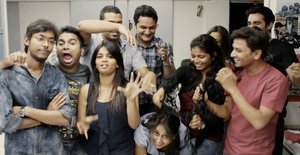Adapting technology in physical environments : Create exuding experiences.
Branded environments in India are evolving. What trends are affecting experiences, how does new technology play a role in design of spaces and how does one connect with the new age end user.
By SHRISH TILEKAR
Experience based environments encompass a variety of sectors in today's world, they span across the service , manufacturing and retail industry .
Within the manufacturing sector, traditional companies, rather than carrying out boardroom presentations, are now setting up experiential spaces to communicate their offering. Working alongside designers companies are creating user journeys to best experience and explain their products & services.
The service industry having realised that customer engagement for good service is about good experiences, are creating positive memories at various touch points. They understand the relevence of this model to keep up in the ever competitive market. Mobile service providers are offering in store expert advice and value added service like free wifi, refreshments in an attempt to give a wholesome experience to their customers.
Banks are adopting user centered approach to design to make customer journey seamless and a pleasant banking experience. Such experiences help create an emotional connect with the customers, helping build long lasting relationships enabling a loyal customer base.
Hotels are coming up with theme based rooms to offer exclusive experiences to their guests and to try and present something new each time. Spaces like hotels are emphasising on distinctive moods and perceptions. Themes, lights, textures, alternative seating options make each visit into a novel experiences within a single space.
In Retail, brands have moved past the requirement of maximum SKU displays , brightly lit spaces, and use of multiple colours and materials. They have started to realise the importance of consumer centric designing , thus focussing on creating differentiated journeys and better experiences in the space which do not directly relate to the selling of the product but to build lasting memories , loyalty and superior impressions of the brand.
We are seeing a period when local players are realising the need for innovative and creatively designed experiences in the space that would help them compete with the global brands that are storming the Indian markets.
E retailing is also growing at the rate that one had never imagined. Though the e-retailers are changing the way people have been shopping and a complete change in the mindset of these people as well , the brick and mortar stores still hold their own charm amongst these users and also are an important element in the marketing mix.
Over the last two decades advancements in technology and the rising internet and mobile phone penetration has changed our lives and the way we communicate, do business and the way we shop or receive a service.
Technology has reinvented almost every aspect of the journey of a user within spaces through new ways of browsing, digital shopping cart, reinventing changing rooms, sizing and customising on screen, in store remote video broadcast, real time SKU tracking, multiple payment options and methods. Technology is affecting how a store operates, thus presenting a completely new canvas to the designer.
Design will not just be restricted to one channel but there will have to be a holistic approach towards omni-channel retailing. Design of these physical spaces will have to be thought of keeping in mind other channels, where essentially the same kind of experience will have to be replicated or where the digital experience will have to be seamlessly integrated with the physical space. It is about the digital interactions and journey that comprises of human to space ,space to human, human to digital and digital to human interactions.
One such current technology is the mPOS ( mobile point of sale). The introduction of this technology has comprehensively transposed the journey of a user in any given environment.
It eliminates cash counters, queues, paper receipts, dependency on wired or even WIFI internet connections, bulky billing devices, and much more. For the customers it means safe transactions, cash free wallets, hassle free multiple payments and no long boring queues, all this for more shopping time with a better experience.
User fast adapting to new tech, are also evolving simultaneously. The needs and the demands of these users have changed drastically prompting the brands and the designers to take quick steps towards creating environments to suit their expectations. In this scenario designing environments will be more about mapping an experience of a target customer and less about clever furniture or a different looking space. Experience Retail will be less about trying to sell more things but moreso be focused towards great customer therapy.
Retail will no longer be just a place to buy. It will be more of social zones, hangout places, informative and educative. It will be a place that provides a holistic experience and a seamless integration with out-of-store engagements. People manning these places will be a lot more than just sales people. They will be the facilitators to conversations, educators and also designers that would make changes in the journey of a user based on his past experience with that particular user. Personalisation of experiences will be taken beyond the visible expectations of a customer like on the go, adventurous, relaxing, involving and so on.
Designers now will play a crucial role as an integrator, showing keen understanding of new tech, e commerce and people psyche’.
SHRISH TILEKAR is a Senior Designer, Environment Design at Elephant. An alumnus of National Institute of Design, Bangalore and with a Masters from IED, Milan, he leads a cool team of designers focussing on retail, special functional spaces and branded environments.
















